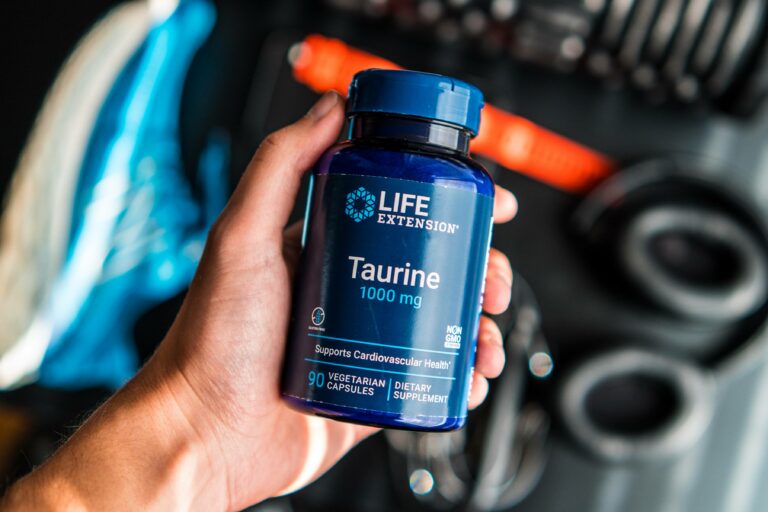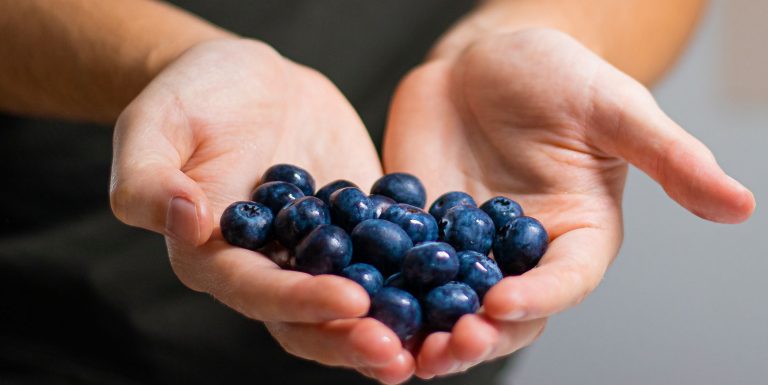7 Benefits of Salmon: Anti-aging, Cognition & Heart Health
Salmon makes it on the superfood list without a doubt. It is considered one of the healthiest fish on the planet, and the best alternative to be consumed instead of meat. The Health benefits of salmon can impact heart health, cognition, anti-aging, and antioxidant status in the body.
Salmon is a reddish fish native to the North Atlantic and the Pacific Ocean. It can live in both fresh and salty water and can travel thousands of miles. Salmon’s lifespan ranges from around three to eight years. It is no surprise this is one of the main fitness clean-protein alternatives, due to its nutritional profile
Salmon Superpowers
Salmon Is loaded with Antioxidants and Healthy Omega3-Fatty Acids which can exert multiple positive effects and improve Health.
Most of its benefits are present due to the fact it contains Astaxanthin, a powerful carotenoid antioxidant, Omega-3 Fatty acids, and Vitamin D.
Salmon is also known for its versatility, I mean think of it. You can eat this fish in hundreds of different combinations since it is tasty whether it is steamed, fried, poached, steamed, or baked.
It is a great, healthier alternative for smoked meat such as bacon, it can be added to salads, pasta, carbohydrate-rich meals, tortillas, sandwiches, creamy sauces, and vegetables. It makes a great combination with almost all the spices and appetizers like lemon, garlic, leek, curry, pepper, lime, honey, balsamic, cilantro, and ginger.
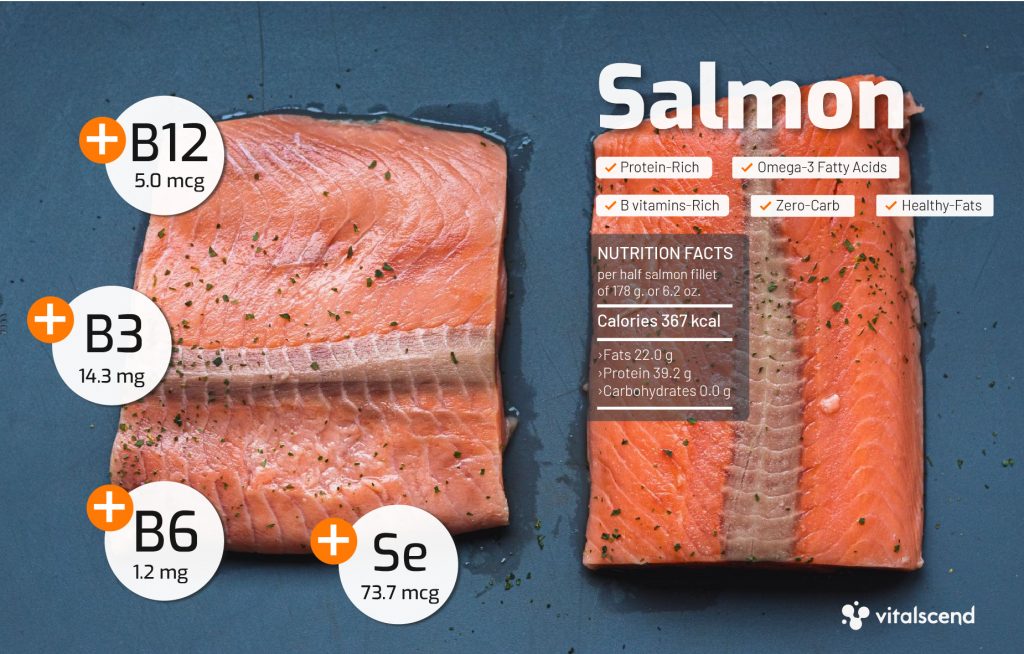
Nutritional profile
Salmon is fat and protein-rich fish, which also contains many powerful antioxidants and minerals.
Salmon is a unique Pescetarian choice because it contains a good amount of B vitamins, which are crucial for energy production, conversion of food to energy, metabolism control, and growth & regeneration.
One salmon serving is around 3.5 ounces (100 grams), and the nutritional profile shown here is of half a salmon fillet which measures around 178 grams or 6.2 ounces.
Here is the Macronutrient and Micronutrient profile that half a salmon fillet offers:
Macronutrients
- Calorie 367 kcal
- Protein: 39.2 grams
- Carbohydrate: 0.0 grams
- Fats: 22.0 grams
Omega Fatty Acids
- Omega 3s: 4023 mg
- Omega 6s: 1185
Micronutrients: Vitamins & Minerals
- Vitamin C: 6.6 mg (11% DV)
- Thiamin (B1): 0.6 mg (40% DV)
- Riboflavin (B2): 0.2 mg (14% DV)
- Niacin (B3): 14.3 (72% DV)
- Vitamin B6: 1.2 mg (58%)
- Vitamin B12: 5.0 mcg (83% DV)
- Magnesium: 53.4 mg (13% DV)
- Phosphorus: 449 mg (45% DV)
- Potassium: 683 mg (20% DV)
- Selenium: 73.7 mcg (105% DV)
From the nutritional profile it offers, we can see Salmon is pretty rich in Selenium, Omega 3s, and Vitamins like Niacin, B6, and B12.
It has no carbohydrates, which is familiar with meat, and high amounts of proteins and healthy fats, being the main reason why it is mostly buzzing in the fitness world, besides chicken and eggs, salmon deserves the spot as the clean high-protein alternative.
Salmon Health Benefits
Salmon has been given the title of “the healthiest fish” for a reason. Salmon has become popular not just because of its delicious taste and versatility, but because of the multiple health benefits it provides.
Fun Fact
Wild-caught salmon is the healthiest variety or type of salmon you can get. The difference between wild and farmed is the ratio of omega 3s vs omega 6s fatty acids. Omega 3s are higher in wild-caught which provides us with more brain-supportive and anti-inflammatory properties.
This healthy, nutrient-dense fatty fish contains many vitamins and minerals at a reasonable dosage to affect health positively. In fact, eating this fish for two-three servings a week can provide us with daily recommendations for specific vitamins and minerals.
Most of Salmon’s benefits come from its omega-3 fatty acids, but don’t be fooled, salmon is way more than just a good omega-3 food source. Salmon is also high in Astaxanthin, B vitamins, Potassium, Selenium, vitamin D and has a pretty good amino-acid profile.
It is one of the best fitness foods on the market, due to its high protein content, fats that affect satiety, omega 3s that reduce inflammation from exercise, and B vitamins to help support optimal function and growth.
Rich Source of Omega-3 Fatty Acids
Anti-inflammatory, Brain Support, Heart Health, Mood Elevation
Omega 3 Fatty Acids are polyunsaturated fatty acids, also referred to as PUFAs which can provide multiple health benefits and support organ function.
Since they are essential, we must eat foods rich in omega 3, because our body doesn’t make them on its own. Three main types of Omega 3 Fatty Acids are:
| ALA or alpha-linolenic acid | found in plant oils like flaxseed, walnut, algae, and hemp oil |
| EPA or Eicosapentaenoic acid | found in fish like tuna, salmon, cod liver, herring, and seal blubber |
| DHA or Docosahexaenoic acid | found in fatty fish, eggs, caviar, algae, and Seaweed |
Fun Fact
EPA & DHA originate from the aquatic ecosystem. Fish are rich in omega3-s, because of what they eat. Fish in the sea eat algae, which are loaded with tones of nutrients found in fish, the main one being EPA and DHA content.
One serving of salmon weighs around 3.5 oz. (100 grams) and half salmon fillet weighs around 178 grams (6.27 oz.) One serving of 100 grams of wild-caught salmon contains around 2.5 grams of omega-3 fatty acids.
These polyunsaturated fats have been shown to reduce levels of cytokines, eicosanoids, and reactive oxygen species, which can, in turn, reduce inflammation. Omega-3s can alter the expression of inflammatory genes by affecting transcription factor activation. (1)
- Polyunsaturated fats have been shown to reduce levels of cytokines, eicosanoids, and reactive oxygen species, which can, in turn, reduce inflammation. (1)
- SPA and DHA in salmon may reduce pro-inflammatory cytokines significantly both at dosages of 10 micromol/L and 100micormol/L, research shows. (2)
- EPA and DHA which can be obtained through diet were found to reduce hypertension and blood pressure. This suggests a potential benefit in supporting heart function and health. (3)
Adding foods such as walnuts, flax seeds, and fatty fish can be a great way to increase Omega 3 levels which can modulate inflammation and improve lipid metabolism. A higher intake of Omega 3 has been associated with reduced mortality. (4)
Omega 3 is also associated with brain performance and improved cognition. In a 30-day period, EPA supplementation was more efficient and exerted effects similar to improved cognition with less work stress, compared to DHA. (5)
summary
Salmon is fatty fish loaded with omega-3 fatty acids, such as DHA and EPA which have many benefits on human health, ranging from supporting brain function & heart health to reducing inflammation and disease prevention.
1. Improves Brain Performance
Salmon has a brain-supportive nutrient profile since it contains many nutrients that are associated with better brain health, performance, and many neuroprotective benefits.
Besides Omega 3 fatty acids which play a major role in reducing inflammation, other nutrients found in salmon can also affect brain performance, and these are:
- Choline
- DHA (omega-3 fatty acid)
- Vitamin B6
- Vitamin B12
- Selenium
In this section, we will review some effects of these nutrients on brain performance, neuroprotection, mood enhancement, and inflammation.
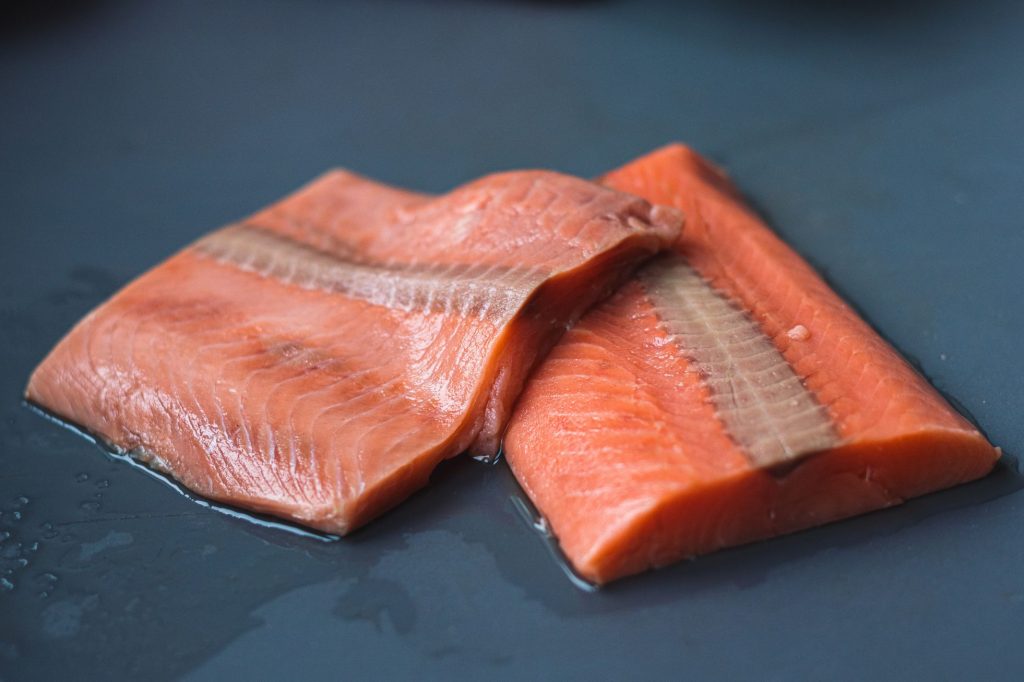
Mood enhancement, Treat Anxiety & Depression
Vitamin B6 is important in mood regulation and mental function. B6 deficiencies have been associated with neurodegeneration, mood swings, migraine, and depression. (6) In this research, they found that lower levels of B6 are associated with depression since B6 plays a major role in serotonin creation. (7)
Inflammation in the brain can alter brain structure and affect neurotransmitter levels. Since salmon is rich in omega 3, it can improve the omega 3:omega 6 ratio, which can be beneficial since it can reduce inflammation and improve brain function. Many inflammation-related brain problems can be associated with mood swings, bipolar disorder, and depression. (8)
Omega 3s can also affect BDNF (Brain-derived neurotrophic factor) which is an important compound involved in brain neuroplasticity, neural link connection, and development. (9)
Biohack
Salmon is one of the richest food in Tryptophan which may affect mood. Tryptophan is an essential amino acid that can be converted into 5-HTP, a molecule used to make serotonin. Serotonin can elevate mood, it is known as “the happiness hormone”. The problem is tryptophan from food can’t cross the blood-brain barrier, because of the other amino acids competing. But consuming carbohydrates along with tryptophan can increase the chances of it, being absorbed.
Cognition & Learning
Vitamin B12 is crucial for brain development and optimal function of the nervous system, as well as other B vitamins. Deficiency in vitamin B12 may result in brain shrinkage or atrophy and memory impairment.
- A specific marker of vitamin B12 deficiency known as Methylmalonate may negatively impact cognition and reduce brain volume. (10)
- Vitamin B12 can also support axon growth and improve nerve repairmen. B12 is used in peripheral nerve injury and may have neuroprotective properties. (11)
Memory & Neuroprotection
Lower levels of B12 Vitamin are associated with impaired learning abilities and lower micro-structure integrity in the hippocampal region of the brain, as well as impaired memory. (12)
Choline is an important nutrient in salmon which may protect the brain against cognitive decline. Choline is an acetylcholine precursor and acetylcholine plays role in nerve cell signaling.
- Higher levels of Choline in rat mouse models were associated with improved cognitive function and prevented age-related cognitive decline.
- Choline may alter the expression of genes that encodes proteins that play a major role in memory and learning. (13)
- Salmon is rich in Selenium, an important mineral. Lower levels found in the hippocampal region, the cortex, and temporal brain regions are associated with neurodegenerative diseases like Alzheimer’s Disease. (14)
The combination of vitamin B12 and Omega 3 was shown to improve cognition and reduce cognitive decline. DHA was more effective than EPA, to enhance B vitamin cognitive effects. Only when omega 3 levels are high B vitamins can slow cognitive decline. (15)
summary
Salmon can support healthy brain function and elevate mood. It contains the key brain-supporting nutrients such as choline, B vitamins, Omega 3s, and proteins which play a crucial role in brain development, neurotransmitter production, and healthy brain aging.

2. Build Lean Muscle and Improve Strength
Improves Performance, Protein-rich source
The main reason behind the buzz of Salmon being one of the top fitness foods has been its protein-rich profile combined with healthy fats.
In body recomposition, fitness, or hypertrophy training, a couple of things are important:
- Energy for ATP production
- Protein & Amino acids for building muscle
- HGH and Testosterone stimulation
- Antioxidant-like effect to reduce inflammation
It seems that Salmon, with its nutritional profile, can support many of these functions.
Salmon is rich in B vitamins, especially vitamin B3 (Niacin), Vitamins B6 and B12. B vitamins are long known to ensure proper development and aid in the conversion of food to energy, acting as co-enzymes that are necessary for the action of the enzymes themselves. B vitamins play a major role in the metabolism of carbohydrates, proteins, and fats. (16)
First of all, being a rich source of protein, Salmon contains about 18 grams of protein in only one serving which measures around 3.5 ounces. Besides chicken, nuts, and eggs, salmon holds one of the best amino-acid profiles in lean-protein foods.
Biohack
To ensure proper absorption of Salmons amino acids, you should consume a high-quality wild-caught salmon (the best version) and reduce thermal processing or sterilization, because they can decrease protein digestibility. Cook your salmon on low heat, with olive oil and water, bake it or eat a smoked version and add some lemon to it.
Fish, especially salmon is a great muscle-building option, due to its complete amino acid profile. Atlantic Salmon contains:
| Arginine | Valine |
| Histidine | Phenylalanine |
| Isoleucine | Threonine |
| Leucine | Tryptophan |
Many supplements on the market use BCAA’s which contain isoleucine, leucine, and valine. All of these three amino acids are important for muscle growth and are present in salmon.
- Omega 3’s from Salmon can reduce muscle-protein breakdown and have an anti-inflammatory effect which can, in turn, improve your performance on the next workout.
EPA and DHA can directly enhance the rate of muscle protein synthesis and decrease muscle breakdown while improving mitochondrial respiration. (17) (18)
- Another important vitamin is Niacin, which may have beneficial effects. Keep in mind that these effects might be over-exaggerated since the studies on Niacin have higher dosages than a regular-size salmon serving.
- Salmon is rich in Vitamin B3, also known as Niacin which can act as a vasodilator. This will definitely affect one’s pump levels and may provide additional benefits in nutrient and oxygen transport. (19)
- Niacin was also shown to increase levels of Human Growth Hormone which is the main muscle-building, protein-synthesizing hormone in the body that regulates growth. The underlying mechanism in obese children was Niacin’s ability to suppress free fatty acids which then elevated HGH levels. (20)
summary
Due to its high protein and healthy fat content, salmon earns its spot as a great fitness option. It has a great amino-acid profile and B-vitamin content which can support muscle growth, improve energy metabolism, increase HGH, and reduce inflammation, which can enhance athletic performance.
3. Promotes Heart Health
May Lower blood pressure | provides nutrients
There was a study named “a fish a day, keeps the cardiologist away” which evoked this interest in me to research fish’s effects on the cardiovascular system. FDA recommends eating 8 ounces or 2 servings of omega-3-rich fish on a weekly basis.
Omega 3 fatty acids found in fish, were shown to improve the tone of the parasympathetic and sympathetic system, increase nitric oxide synthesis, and balance lipid levels. Due to their antiatherogenic, antiarrhythmic, anti-trygliceridemic, and antihypertensive properties, they can improve cardiovascular health. (21)
Dislacimer: people with cardiovascular diseases or at a higher risk of developing one, must consult with a doctor and do an examination to find the optimal dosing that suits his/her needs.
Lower blood pressure & Anti-inflammatory effects
Because salmon contains a combination of anti-inflammatory omega3s and vasodilatory niacin (vitamin B3) there is no surprise it can affect the cardiovascular system.
In this Meta-analysis, they reviewed 16 total studies with 901 participants, for the usage of omega 3s and reduced risk of cardiovascular diseases. They found that 0.45 to 4.5 g/d improved endothelial function. (22)
Salmon is rich in Potassium, a mineral that can reduce water retention and blood pressure, especially in high-sodium diets. In one-half salmon fillet (178 grams), there is 683 mg (20% DV) of Potassium.
Adding salmon to a high-sodium diet may reduce blood pressure, due to its high potassium content. Potassium was shown to reduce systolic and diastolic blood pressure by 3.11 mmHg and 1.97 mmHg respectively. (23)
So how can salmon act to improve our cardiovascular health? Here’s the magic
- Lowers blood pressure
- Balances Lipid levels
- Improves circulation (Nitric oxide)
- Provides essential nutrients to support heart function
- Reduces blood clotting
- Lowers Triglyceride levels
- Reduces irregular heartbeat or arrhythmia
Cleaner, omega-3 enriched and lower in mercury, leaner fishes as great salmon alternatives are Shrimp, Pollock, Catfish, Albacore tuna, Herring, Sardine, and Lake Trout.
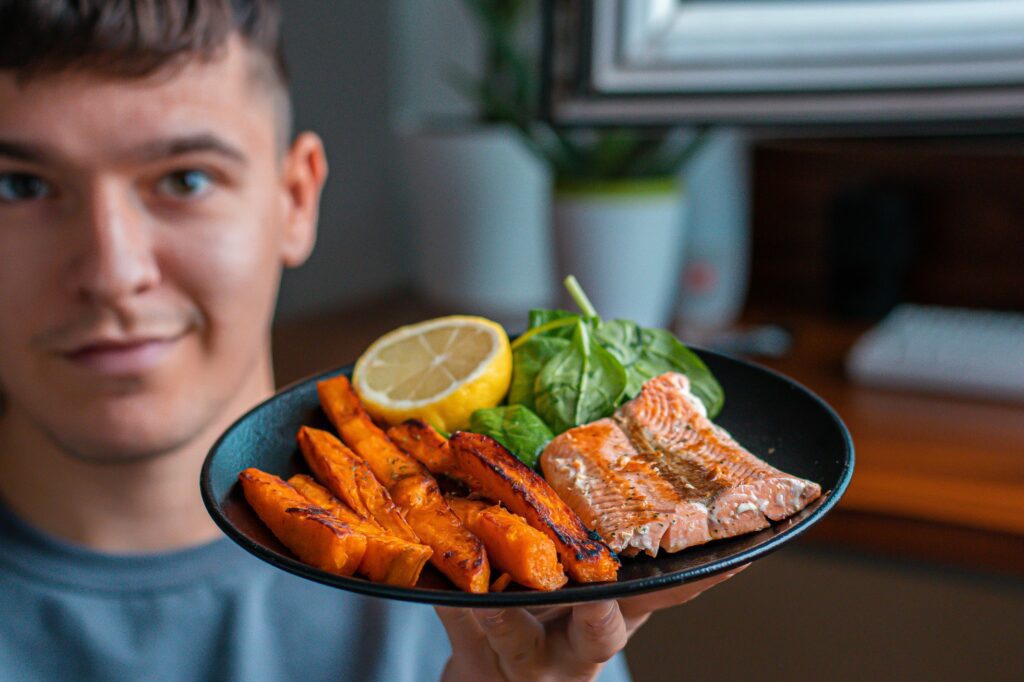
4. Astaxanthin Special, Powerful Antioxidant
Improves cholesterol profile, Reduces neuro-inflammation
Fun Fact
Astaxanthin is a powerful antioxidant found in salmon. It is a bioactive compound, a keto-carotenoid, and a pigment, which gives shrimp and salmon their unique pink-red-orange color. It is present in microalgae, plankton, krill, and seafood
Astaxanthin can positively affect the heart and cut the risk of developing cardiovascular diseases because it affects one of the main markers, the oxidized LDL. Astaxanthin-rich seafood option: (look for reddish-orange intense color)
- Salmon
- Shrimps
- Lobsters
- Crayfish.
Astaxanthin can affect and attenuate inflammation and oxidative stress, which are one of the major factors associated with cardiovascular diseases. It may also decrease markers of lipid peroxidation and thrombosis. (24)
- Astaxanthin was also found to reduce levels of LDL and increase HDL levels. Many of its benefits come from the antioxidant-like effects it has, to scavenge free radicals and prevent atherosclerosis. (25)
- LDL oxidation is a process in which LDL molecules react with unstable free radicles and produce oxidized LDL molecules which are detrimental to your cardiovascular health.
- This bioactive compound, Astaxanthin can also slow down or inhibit LDL “the bad cholesterol” or “low-density lipoprotein” oxidation. (26)
Fun Fact
The longest-living people, also known as centenarians live in the Blue Zones. Aside from the plant-based dominance in their diet, they also eat fish and seafood like Albacore Tuna, Salmon, Oysters, Coho Salmon, Wild-caught Sardines, Shrimp, Crab, Scallops, and Cod.
Omega 3’s and Astaxanthin may improve brain health by reducing neural inflammation, hindering neurodegeneration, and enabling you to sustain mental and cognitive performance & capacities longer. (27)
Astaxanthin may also be a potential agent in preventing neurodegenerative diseases such as Alzheimer’s and Parkinson’s diseases, due to its neuroprotective and anti-inflammatory effects. (28)
summary
Incorporating Astaxanthin rich foods such as salmon, trout, shrimp, lobster, and fish eggs are more beneficial in terms of astaxanthin absorption and effect because the synthetically produced astaxanthin doesn’t have the same antioxidant-like effect (present in most, but not all supplements).
5. Supports Strong and Healthy Bones
Rich in Vitamin D and Phosphorus
Salmon contains many bone supporters such as Vitamin D, Phosphorus, and Omega 3 fatty acids.
Fatty fish is usually good for the bones because of their vitamin D content, which plays a major role in Calcium absorption and building strong bones.
Vitamin D
Calcium
Omega 3 FA’s
Phosphorus
Even if the sun gives us the best vitamin D, in the times of winter or lockdown where we are not exposed to it, experts recommend 1,000 IUs of D3. Fish such as salmon and mackerel are a great source of vitamin D. (29)
Vitamin D deficiencies are associated with weak bones, increased risk of bone fractures due to lower bone density, and mineralization defects. Supplementing with Vitamin D can improve mineralization and decrease bone turnover. (30)
Even though salmon contains small amounts of calcium, it can supplement or be an addition to elevate calcium levels and meet the requirements. In this study, they found out that calcium absorption from Atlantic salmon and cod bone is well absorbed in young healthy men. (31)
In 9 male patients with osteoporosis, subcutaneously, 100 units of salmon calcitonin and calcium improved bone mineral density in the lumbar spine and femoral bone. (32)
Omega 3 Fatty acids may be a potential agent in reducing or preventing osteoporosis since they can reduce inflammation, inhibit bone breakdown, and increase calcium absorption. (33)
A combination of omega-3s, ALA, and calcium may be beneficial for preventing osteoporosis or improving bone-related outcomes and supporting healthy bones. Omega 3 supplementation was more efficient in combination with calcium and other minerals and vitamins that support healthy bones. (34)
Another mineral found in Salmon is phosphorus, which was shown to have positive effects on bone mineral content (BMC) in female teenagers and bone mineral density (BMD) in adults. (35)
summary
Salmon contains many bone-supportive agents such as minerals: phosphorus & calcium, omega 3s, and vitamin D. All of which can influence bone strength & health, calcium absorption, and reduce the risk of osteoporosis.
6. Promotes Healthy Skin
Collagen production, Sun damage, Skin regeneration
This fatty fish can also affect and heal your skin. It is a beautiful tonic that can transform you from the inside out.
The main reason behind Salmons’ effect on skin regeneration lies in its anti-inflammatory effects, but besides that, it provides many important nutrients for the skin.
Fats from salmon can feed your skin to produce the oil it needs, instead of using synthetic oils or drying out.
Clear & Smooth Skin
Omega 3 fatty acids found in salmon can inhibit pro-inflammatory eicosanoid production, which reduces inflammation and they can also accelerate wound healing. Not just EPA and DHA, but also LA and ALA have therapeutic effects on the skin. Omega 3s can also improve skin barrier function, inhibit hyperpigmentation UV damage, and attenuate dry skin. (36)
Supplementation with Marine Collagen Peptides improved the patient’s skin elasticity, dermal ultrasonic markers, and sebum production. (37) Sebum helps in lubrication and skin protection. Sebum deficiency results in cracky, dry, irritable skin.
Anti-wrinkle Effect
Another important antioxidant is the carotenoid Astaxanthin, present in Salmon.
Astaxanthin may exert some skin-protective and skin-regeneration benefits due to its antioxidant and photo-protective properties. The main mechanisms behind its effects are inhibition of collagenases, MMP activity, free radicals, and inflammation which can produce many anti-wrinkle effects, making your skin look fresh and young. (38)
In 65 healthy female participants, they examined Astaxanthin effects on skin deterioration for 16 weeks period. Due to environmental factors such as UV and dryness skin factors in the controlled group were worsened, while the Astaxanthin group showed no significant difference which suggests its potential use in inhibiting skin deterioration. (39)
summary
Astaxanthin, amino acids, EPA, DHA, and ALA can improve skin health and support skin cell regeneration and growth. Providing healthy nutrients for the skin, salmon can make it in the category of anti-aging foods, due to astaxanthin anti-wrinkle effects.
Frequently Asked Questions
Is wild-caught salmon better than farmed salmon?
The major difference between a farmed and wild-caught salmon is the ratio of omega 3 fatty acids vs. omega 6 FAs. Wild caught salmon is considered to be healthier due to its higher quantity of omega 3 fatty acids which have many brain-supportive and anti-inflammatory properties.
What color should the skin of salmon be?
Fresh wild-caught salmon should be orange-pink color. The presence of a powerful antioxidant known as astaxanthin is the reason for its reddish, bright color. Astaxanthin also gives shrimps their unique color similar to salmon, and Is also present in plankton and krill. It is a keto-carotenoid pigment
What are the health benefits of eating salmon?
The benefits of eating salmon mainly come from its nutritional power. It is highly nutritious, providing high-quality protein, omega 3 FAs and other healthy fats. It is rich in antioxidants such as astaxanthin, and specific vitamins and minerals. This combo may lead to reduced inflammation, brain-support, cardiovascular health, muscle growth, libido boost, energy increase and strong & healthy bones.
Is salmon a nutrient-rich food?
Yes, sure. Especially wild-caught salmon is very nutritious. It provides up to 367 kcal per 100 gram fillet, it has a ton of omega 3 fatty acids (around 4.000 mg), and is rich in B vitamins, vitamin C, magnesium, potassium, phosphorus, selenium and niacin.


